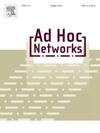基于仿真的高效水下传感器网络鲁棒优化设计框架
IF 4.8
3区 计算机科学
Q1 COMPUTER SCIENCE, INFORMATION SYSTEMS
引用次数: 0
摘要
由于事件驱动的数据峰值、动态环境条件、传播延迟和数据缓冲等原因,传感器的数据生成速率可能会在配置阶段偏离预期,因此设计鲁棒的传输方案对于水下无线传感器网络(UWSNs)至关重要。尽管水下技术取得了进步,但在交通不确定性下的UWSN优化仍未得到充分探索。本文提出了一种新的基于仿真的鲁棒优化框架,用于设计高能效UWSNs。我们首先全面回顾了解决无线网络设计系统参数不确定性的文献,然后分析了专注于水下物体运动建模的研究。然后,我们提出模拟一个入侵检测环境,其中包括移动目标,如自主水下航行器和沿着3D路线航行的潜艇。为了提高模拟精度,使用真实的水深数据来定义系统元素(包括车辆、传感器和海洋地形)之间的相互作用。然后,利用多次模拟运行的结果确定传感器的预期数据生成率和相应的允许间隔。结果数据集用于确定并对最优确定性和鲁棒性配置进行综合分析,其中分配给传感器的最大电池量最小。确定性配置和鲁棒配置之间基于场景的网络功能时间比较表明,在所有数据速率实现中,鲁棒设计的性能大大优于确定性配置,即使在与预期偏差最小的情况下也是如此。本文章由计算机程序翻译,如有差异,请以英文原文为准。
A simulation-informed robust optimization framework for the design of energy efficient underwater sensor networks
Given that data generation rates of sensors might deviate from what is anticipated during the configuration phase due to several reasons such as event-driven data spikes, dynamic environmental conditions, propagation delay and data buffering, etc., designing robust transmission schemes is pivotal for Underwater Wireless Sensor Networks (UWSNs). Despite advances in underwater technologies, UWSN optimization under traffic uncertainty remains underexplored. This paper presents a novel simulation-informed robust optimization framework for designing energy-efficient UWSNs. We begin with a comprehensive review of the literature that addresses uncertainty in system parameters for wireless network design, followed by an analysis of research focused on modeling the motion of underwater objects. Then, we propose simulating an intrusion detection environment that includes moving targets, such as autonomous underwater vehicles and submarines navigating along 3D routes. To improve simulation accuracy, real bathymetric data is used to define the interactions between system elements including vehicles, sensors, and ocean topography. Then, the expected data generation rates of sensors and the corresponding admissible intervals are determined using the results from multiple simulation runs. The resulting data set is used to determine and conduct comprehensive analyses on optimal deterministic and robust configurations, where the maximum battery allocated to a sensor is minimized. The scenario-based comparison of network functional time between deterministic and robust configurations indicates that the robust design substantially outperforms the deterministic configuration across all data rate realizations, even at the lowest level of deviation from the expectations.
求助全文
通过发布文献求助,成功后即可免费获取论文全文。
去求助
来源期刊

Ad Hoc Networks
工程技术-电信学
CiteScore
10.20
自引率
4.20%
发文量
131
审稿时长
4.8 months
期刊介绍:
The Ad Hoc Networks is an international and archival journal providing a publication vehicle for complete coverage of all topics of interest to those involved in ad hoc and sensor networking areas. The Ad Hoc Networks considers original, high quality and unpublished contributions addressing all aspects of ad hoc and sensor networks. Specific areas of interest include, but are not limited to:
Mobile and Wireless Ad Hoc Networks
Sensor Networks
Wireless Local and Personal Area Networks
Home Networks
Ad Hoc Networks of Autonomous Intelligent Systems
Novel Architectures for Ad Hoc and Sensor Networks
Self-organizing Network Architectures and Protocols
Transport Layer Protocols
Routing protocols (unicast, multicast, geocast, etc.)
Media Access Control Techniques
Error Control Schemes
Power-Aware, Low-Power and Energy-Efficient Designs
Synchronization and Scheduling Issues
Mobility Management
Mobility-Tolerant Communication Protocols
Location Tracking and Location-based Services
Resource and Information Management
Security and Fault-Tolerance Issues
Hardware and Software Platforms, Systems, and Testbeds
Experimental and Prototype Results
Quality-of-Service Issues
Cross-Layer Interactions
Scalability Issues
Performance Analysis and Simulation of Protocols.
 求助内容:
求助内容: 应助结果提醒方式:
应助结果提醒方式:


